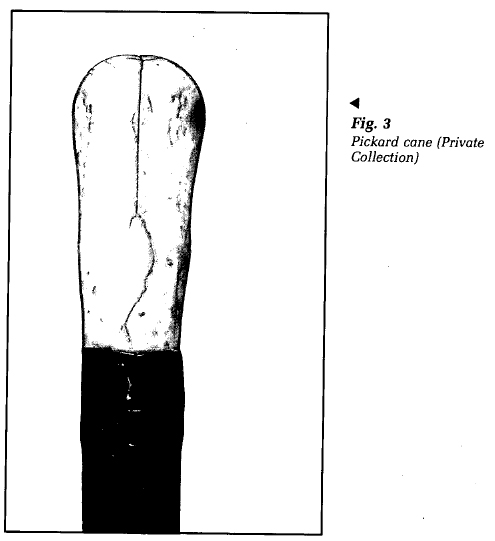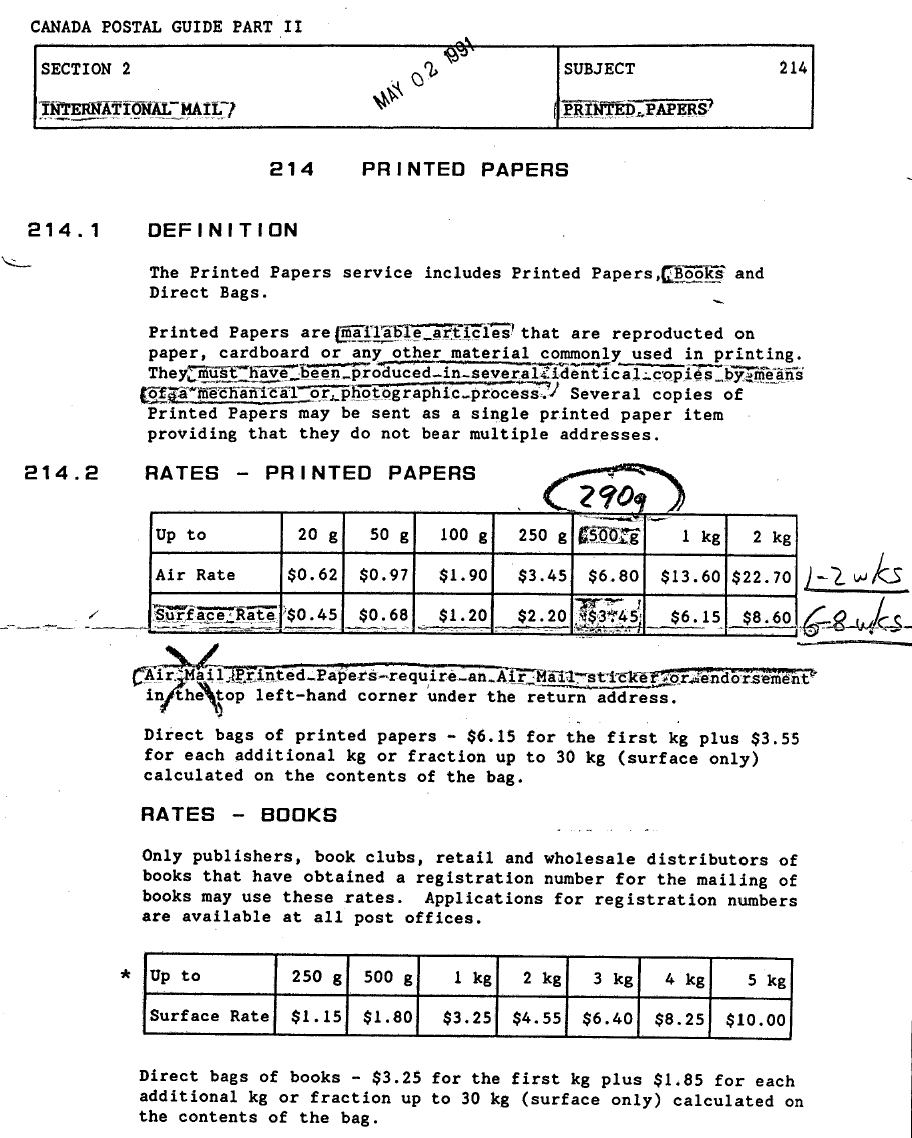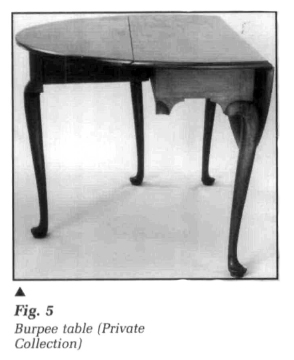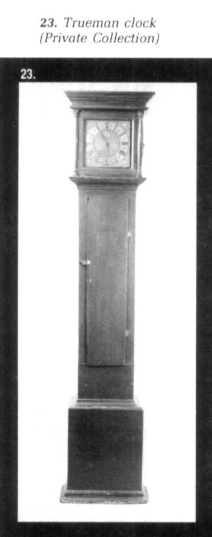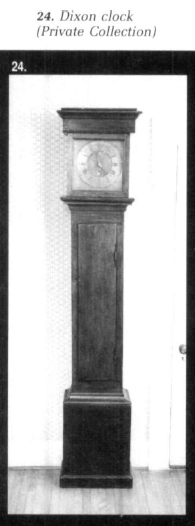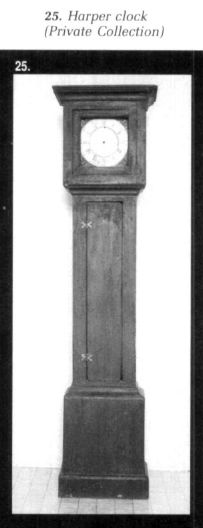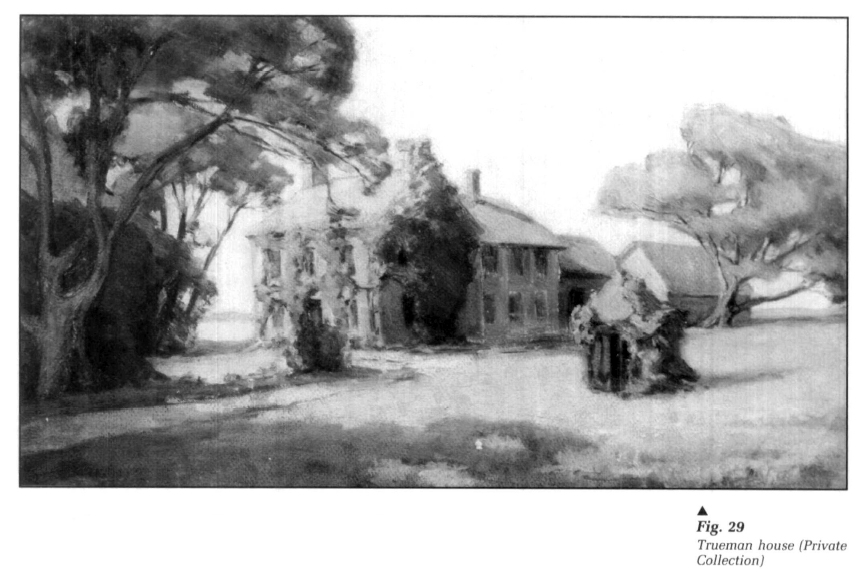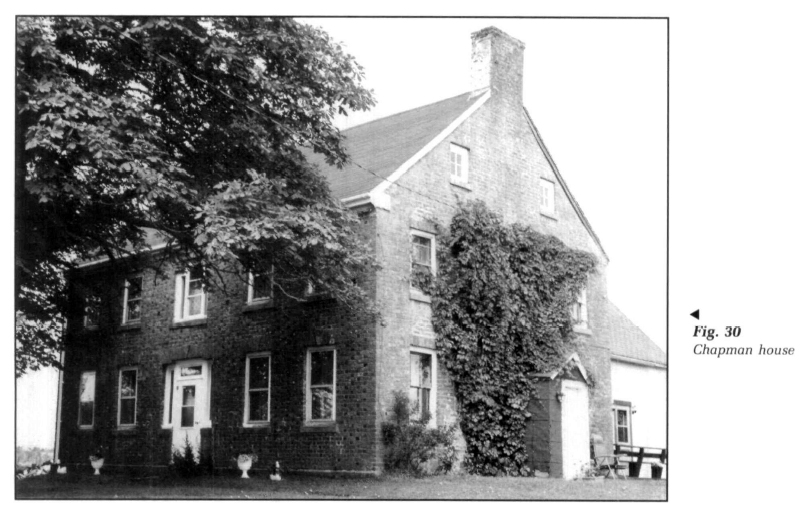Articles
Before the Loyalists:
The Material Culture of New Brunswick's Early English Settlers
The English-speaking settlers who came to New Brunswick before the 1783 arrival of the Loyalists have received comparatively little research attention. In the fall of 1985 the New Brunswick Museum launched a search for any surviving artifacts of these early settlers. This article presents the results to date, focusing on the problems of dating and authentication. By closely examining the artifacts (furniture and pottery, clocks, personal weapons and clothing, maps, documents and portraits) the author speculates on the lives of their owners and the world they inhabited.
Résumé
Les colons anglophones qui se sont installés au Nouveau-Brunswick avant l'arrivée des Loyalistes en 1783 n'ont guère retenu l'attention des chercheurs et des historiens. Le Musée du Nouveau-Brunswick a lancé, à l'automne 1985, une campagne afin de retrouver les objets qui restent de l'époque de ces premiers colons. Cet article fait le point sur les résultats obtenus à ce jour, donne un aperçu de la façon dont les objets ont été retrouvés et examine les problèmes de datation et d'authentification. Les objets découverts (notamment meubles, poteries, horloges, armes personnelles, vêtements, cartes, documents et portraits) sont étudiés afin de voir comment ils peuvent éclairer la vie de leurs propriétaires et le monde dans lequel ils vivaient.
1 "A wise nation preserves its records, gathers up its muniments, decorates the tombs of its illustrious dead." So declared Nova Scotia's illustrious Joseph Howe, addressing a family gathering in New England in 1871. He added that continual reference to past glories and sacrifices fosters a pride in and love of one's country.1 This is advice often ignored in Howe's native Maritimes, especially with regard to a whole generation of its history—the quarter century between 1758 and 1783. Why is this so?
2 Not, certainly, because this was a dull era, for it was full of climactic events. At its beginning thousands of New Englanders flooded in to what was then Nova Scotia, to change irrevocably the character of the former Acadian province; additional tides of Yorkshiremen, Scots, Irish and Pennsylvania Germans followed. All would experience tension with the Indians and be subjected to American privateering raids and land invasions resulting from the mounting political unrest to the south before the revolution of 1776.
3 Nor were these pre-Loyalist English-speaking settlers a dull lot. On the contrary, they were a vital people who determined whether the region would join the American Revolution or stay loyal to the Crown. Later their tough and resilient elite took leading parts in the region's political development, usually on the side of democracy and against autocracy.2 The most probable reason for the neglect of this interesting era is that it falls between two emotional highs—the expulsion of the Acadians and the arrival of the Loyalists, both of which have attracted intense scholarly scrutiny.3
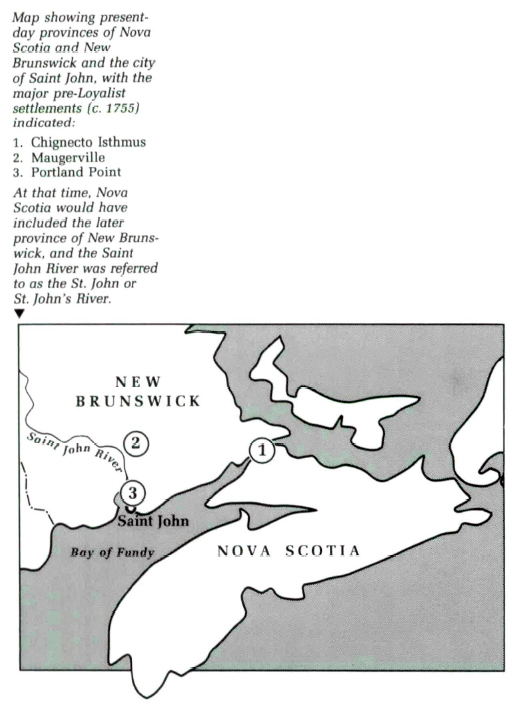 Display large image of Figure 1
Display large image of Figure 14 Although many of New Brunswick's present-day citizens can trace descent from the Pre-Loyalists, the majority have nothing concrete to show for it. Most currently extant pre-Loyalist artifacts belong to two principal groups of incomers, the New England and Yorkshire settlers, and of these only a few families seem to have cherished and preserved ancestral possessions. It is these clusters of artifacts, concentrated in a few regions, and in a few families in those regions, that form the core of this study. One fact stands out: the material survivals do not reflect the differing life-styles of the two groups mentioned above. In general the New Englanders were less affluent than the Yorkshiremen, but nearly as many objects of quality have come down from the "land-hungry" Yankees as from the Yorkshire "men of substance," no doubt because it is a family's best things that are treasured and saved. In addition, the region around Fort Cumberland, where the Yorkshire people were concentrated, suffered heavily in revolutionary raids.
5 When the earliest English-speaking settlers came to the New Brunswick region, the area was still part of Nova Scotia. New Brunswick became a separate province in 1784, a year after the arrival of the Loyalists. The New Englanders arrived first. After most of the Acadians were deported, expelled because they would not swear allegiance to the British Crown, Nova Scotia's governor, Charles Lawrence, issued a proclamation which sought to attract Protestant New Englanders to the vacated Acadian territories. When published in the Boston Gazette in October 1758 the announcement drew many inquiries, and was followed a few months later, in January 1759, with a second proclamation outlining generous conditions—in effect, free land. After a century and a half of settlement, the best land in New England was gone; what was left was scarce and expensive. Over the next few years some seven thousand New Englanders moved north to take up land in Nova Scotia. In the region that would become New Brunswick they mainly settled in Sackville and Cumberland townships on the Chignecto Isthmus, and on the lower St. John River [also referred to as the Saint John or the St. John's River in documents of the time], where the major settlements were at Maugerville and at the mouth of the river.4 These new settlers (or Planters, as contemporaries called them) brought some goods and money, but they were not wealthy. Most of the Maugerville settlers, of Puritan descent from Essex County, Massachusetts, came with a little capital, farming experience and enough craft skills for a high degree of self-sufficiency. Among their surnames, many of which remain current in the district today, were Barker, Burpee, Estey, Jewett, Peabody and Pickard. Three of the families (Burpee, Peabody and Pickard) owned items which can still be located. Records indicate that the settlement straggled for miles along the riverside, and that while some houses were built of sawn lumber from nearby Jewett's Mills, log construction remained popular for many years.5 Among surviving estate inventories, which cast some light on the material wealth of the community, is that of Deacon Jonathan Burpee, who died in 1781. He was considered well off, one of the wealthiest men in the area, yet at this date, eighteen years after he arrived in 1763, the total value of his furniture is given as five pounds, seven shillings and eight pence. It included four bedsteads, two large and ten small chairs, a looking glass and two tables.6 A Burpee family table, perhaps one of these, is studied here.
6 The St. John River connected these settlers with Portland Point on the Bay of Fundy and the Simonds, Hazen and White trading post from which they received essential supplies. The traders, James Simonds, William Hazen and James White, had been officers in Massachusetts regiments that served in the British forces under General Jeffrey Amherst. With other associates in Newburyport and Boston they had set up the post in 1762, and over the next few decades its commercial activity was considerable. The account books show that in the twelve years between 1764 and 1775 the firm shipped $100,000 worth of goods such as furs, oak staves, fish and lime from the nearby quarries. For two years during the American Revolution the post suffered constant raids, looting and occupations, but survived to resume operations and to serve a suddenly expanded community when several thousand Loyalist refugees arrived on transports from New York, to create an instant city—Saint John, New Brunswick, in 1783.
7 Although no furniture from the Simonds, Hazen and White families has turned up, two of their pottery trade milk pans, or platters, were found during the excavation of Portland Point in 1955-56,7 while William Hazen's map powder horn is a survival of outstanding quality. No other artifacts demonstrate the type of life-style and furnishings to which these trading families were accustomed before 1783, although it is certain that comfort levels fluctuated with the fortunes of trade, and even more, of war. At times the life-style at Portland Point had been "not only comfortable but Genteel," complete with fine table linen and furnishings, but during the troubles and destruction of the revolutionary war the women and children lived in a rough log cabin hidden inland beyond a marsh, reduced to bare necessities.8 Yet the families later secured prosperity as is indicated by the five oil portraits illustrated and discussed in this article. Very few people could have afforded the journey to Boston to be painted by leading artists of the day.
8 Not all the New England Planters who took up land grants stayed. Many became discouraged by the arduous work of pioneer farming, by a trade depression and later by the troubles arising from the oncoming revolution, and returned home. This trend was especially pronounced in the Chignecto area by the early 1770s. Governor Michael Francklin, with others who owned extensive land grants in the area, set about attracting new settlers, concentrating their efforts in Yorkshire, England. Here they reached a group of prosperous tenant-farmers who had become dissatisfied with their landlords' policies of enclosing land and/or raising rents sky-high, and also with the unstable economy.9 Religion was an added factor, for most were followers of John Wesley's Methodism, and subject to ridicule and persecution in their homeland. The land Francklin offered seemed remarkably cheap, and many families grasped the opportunity to re-establish themselves under such promising circumstances.10
9 They were "men of substance," so described by two of their number who went out to look over the offered land.11 In addition to sufficient cash in hand to buy extensive farms, these people from Yorkshire understood the techniques of advanced farming and how to reclaim the marshland dykes of the Acadians. This latter knowledge was not well understood by New Englanders, but familiar to inhabitants of the low-lying areas of Yorkshire.12 These men put their funds into land, improvements and strongly built houses. The type of furniture that figures in the list of Yorkshire artifacts reflects their good sense: plain, sturdy pieces of handsome but eminently practical design.
10 Groups of Yorkshire settlers arrived in the Sackville-Fort Cumberland area over the years 1772 to 1775, just as the revolutionary war was about to break out. During its course they would suffer considerably through all the privateering, raiding and the 1776 invasion led by Colonel Jonathan Eddy. Unlike many New Englanders who signed a pledge of loyalty to the revolutionary government of Massachusetts,13 the Yorkshire group, understandably, remained loyal to Britain. They paid for it accordingly, in the frequent plunderings and occasional house burnings of the rebels, and then retaliated, in company with other loyal sympathizers, with similar reprisals. In these acts of destruction the loss of goods and furniture, "the comforts and even the luxuries of life," was undoubtedly heavy.14 It is fortunate that any objects, valuable or otherwise, survive to this day.
11 Charles Dixon, a wealthy leader of the people from Yorkshire, was raided several times; he and his wife saved some silver and other valuables by burying them;15 unfortunately no Dixon silver has yet been located. The family's tallcase clock has survived, with several others owned by Yorkshire immigrants William Chapman, Christopher Harper and William Trueman. The Trueman and Dixon clocks are still in family hands. Other surviving artifacts from this group descend in the Thomas Keillor and William Wells families.
12 One significant survivor gives a clear picture of their style of living—an entire house. Built in 1779 by William Chapman, it is a spacious, many-roomed, two-and-a-half storey structure, constructed of brick made on the property, and with some style and feel for proportions. Similar brick or stone houses were built by other Yorkshire settlers in the Sackville area, notably the Dixon, Trueman and Keillor families.16 They reflect the comfort and style of living to which these people had been accustomed in their former homes.
13 In addition to the two main groups of New England and Yorkshire Planters, several others should be noted. An Inverness Scotsman, William Davidson, established a lumber and fishing community on the Miramichi in 1766. Other English-speaking groups included a few scattered Scots and Irish, of whom we have no known surviving artifacts, and a flourishing colony of Pennsylvania German Protestants, whose twenty families settled about the Petitcodiac River. Some of their names, Anglicized, were Somers, Lutz, Trites and Steeves.17 A substantial pod auger with hand-forged shaft and bit, a tool used in woodworking which belonged to the Lutz family, remains.
14 The initial phase of the study involved an examination of the relevant objects held in the New Brunswick Museum. Further information was gleaned from Museum records, archives, correspondence and exhibition information. Interviews with descendants of the families were also done. In addition to the New Brunswick Museum, sixteen other museums, archives and academics with interest in the field, mostly in New Brunswick, were asked whether they possessed or could suggest where to look for pre-Loyalist objects. Seven replied, two in the negative, two affirmative, three saying it was uncertain but possible that they had pre-Loyalist artifacts. In the last category (uncertain), the Provincial Archives of New Brunswick did indeed have original Planter wills, deeds and account books. The two affirmative replies were from James D. Snowdon of Acadia University, who had a pre-1783 table and clock, and the museum at Fort Beauséjour, whose collections are under the jurisdiction of the Canadian Parks Service of Environment Canada. The fort's holdings of pre-Loyalist material proved to be rich: some twenty possible artifacts.
15 Because of the large number of artifacts found during these investigations, a description of research methods used for each would be repetitious and space-consuming. Accordingly, I have chosen several, of different types, as examples of method: the Hazen powder horn, already in the collections of the New Brunswick Museum; and the Dixon and True-man tallcase clocks, discovered in the field. Research to establish attributions for the oil portraits is also described, but in the comments accompanying the portrait illustrations.
16 Investigation of the Hazen Seven Years' War powder horn was carried out in the winter of 1985-86, when the museum's artifact records were consulted to establish its provenance, a gift from the Sir J. Douglas Hazen estate in 1959. The horn was measured, and the map inscription, name and date ("William Hazen 1761") and other lettering examined with a magnifying glass. Members of the Hazen family, who had known it when it hung on a house wall, were interviewed, and William Hazen's career traced in various biographical and historical sources; information on the methods of preparing and inscribing such horns was gathered. A Hazen descendant had replaced the original wood fittings with heavy silver mountings consisting of a round boss to seal the wide end, a broad-rimmed band near the narrow end and a silver funnel and stopper at the tip. Obligatory marks stamped in the silver were the horn's lion passant mark indicating sterling silver; a leopard's head symbolizing the city of London, England; a black lowercase "e," the mark for the year 1860-61; and the Queen's head meaning duty paid. The initials "J.B." appearing within a round-cornered oblong border were similar to those of several London silversmiths active at that time. It was probably these initials which gave rise to the belief, recorded in the files, that the silver work had been done by Saint John silversmith John Barry. None of the other marks, however, bore this out, but rather were consistent with the probability that the work was done in England in the mid-nineteenth century.18 This fine powder horn proved to be of interest not only for its intrinsic attractiveness, but also for the details of its history.
17 The second methodological example involves two tallcase clocks in the Dixon and Trueman homes in the Sackville area. Each clock was measured, first overall, then bonnets, waists and bases. The wood was examined for type, and the construction scrutinized, with particular attention to the method of joining, tool marks, nail types and other hardware. Insides of waist and hood were searched for notations of dates, makers' names or remarks. The works—pendulum, weights, etc.—where present, were explored, as were the brass clock faces; makers' names, type of numerals and decorative patterns were noted. The clocks were then photographed in detail and family members consulted.
18 With regard to the Dixon clock, the owner produced a letter from a cousin in York, England, giving a reference for the maker's name, afterwards confirmed by consulting relevant reference books. The letter also stated that this clock is mentioned in an account of a Dixon family celebration in 1892, held 120 years after the Charles Dixons arrived.
19 The owners of the Trueman clock, made with only one hand, told of seeing a similar antique one-handed clock during a trip to England in the mid-1970s—in the Cirencester, Gloucester, home of a fellow Ayrshire breeder, who told them that these clocks were not uncommon in that area in earlier times. Such linkages as the two just mentioned, examples of continuity between past and present, have been a constant feature of the research on this project, no doubt because those families who have retained ancestral possessions are conscious of continuity, and actively seek out and enjoy links with the past.
20 In addition to the artifacts illustrated and considered below, some others have been found to be authentic: the Lutz pod auger (at Fort Beauséjour); a simple trestle-top table (larch top, birch legs), which has descended in the Goodwin family, some interior hardware at the Chapman house; the James White officer's commission, as well as a wide variety of other documents such as maps, deeds, and the Simonds, Hazen and White account books.
21 Others are still under study: a silver ladle, definitely by Paul Revere but probably too late in date for this study; a rosehead nailed cradle; two silver teaspoons; and a church candelabrum. Many Planter survivals have, of course, already vanished, discarded as worn out or out of style, or bought by antique pickers from the United States or Ontario and labelled as New England or Upper-Canadian antiques.
22 Technical analysis of the wood objects discussed in the article, done by the wood scientist and technologist of the University of New Brunswick, Fredericton, Dr. Marc Schneider, has provided important information on construction methods and the species of woods used in the construction of chairs, clocks and tables, thus indicating whether a particular artifact would have originated in Britain or North America. Although not done, special photography would add to the information available on the Goodwin drum, revealing what lies beneath the top layer of paint; it would also enhance the nearly vanished writing on the James White commission.
23 The material history field is at present much less developed in Canada than it is in France, in Britain and in the United States,19 where a wealth of technically advanced devices are at hand to assist in the physical analysis and where the literature is extensive. This study on the Pre-Loyalists, venturing into unmapped territories, has presented many problems. For instance, the difficulties of authenticating such a wide variety of objects, involving many fields of expertise, has been enormous.
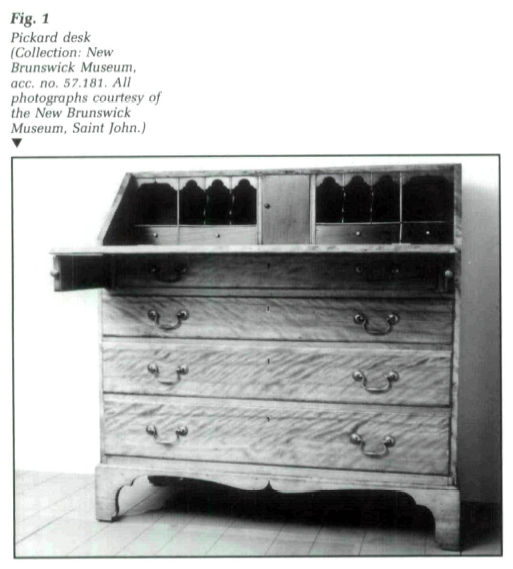 Display large image of Figure 2
Display large image of Figure 224 An examination of some of the artifacts illustrates what these early settlers possessed and also, since they often took steps to pass them on to descendants, what they valued. Some thoughts on how these artifacts can illuminate New Brunswick's cultural history and connect it to a wider world will be found throughout the comments on the illustrated artifacts. A final section will summarize some major conclusions.
Artifact Analysis
Figures 1-4
25 The Pickard material discussed below came to New Brunswick in 1763 when the Moses Pickard family arrived from Rowley, Massachusetts, to take up land on the St. John River at the settlement first known as Peabody's, later as Maugerville. The Pickard ancestors were among the band of non-conformists who in 1639 came to America from Rowley, Yorkshire, in search of religious freedom.
26 This furniture is solidly constructed, plain and practical, and of simple but pleasing design, which perhaps reflects the family's Puritan origins.
27 Evidently a treasured possession, the Pickard desk (fig. 1) of flame or curly birch is mentioned in two wills. Moses Pickard, the original New England settler, bequeaths it to his son, also Moses, in a will dated 1789; it appears again in the son's will of 1848.
28 Desks were popular in the eighteenth century, and generally reflect their owners' social status and degree of wealth. Domestic interior furnishings, sparse in the Middle Ages, increased over the next few centuries in number and complexity, until people in moderate circumstances were accustomed to far more possessions and furniture of more sophisticated types than their ancestors ever knew. By the mid-eighteenth century, desks, once slanted boxes placed on tables or chests, had become united to their supports, and the slant-top desk with a chest of drawers figures in many inventories of the period. These reveal that, after beds, desks were usually the most valuable furniture in the house.20 As an article of conspicuous consumption, elaborate desks were in demand among the wealthy, usually made of mahogany with swelled facades or block fronts and complicated interiors, the whole embellished with inlay or carving. Even unornamented desks of maple or birch were costly; such a one cost £39 in Providence in 1757.21
29 It is in this context that we should look at the Pickard desk which, though plain, is attractively grained, well proportioned and a handsome piece of furniture. Its four main drawers, with birch fronts and pine bottoms, are standard for such desks made in the Boston area,22 and are graduated in size. Their bale handles have been replaced; the originals appear to have been of Chippendale pattern with flat brass backplate. The base has scroll-cut bracket feet and graceful ogee, or cupid's bow, curve. The hinged lid, on lid supports, opens to an interior with six pine pigeon holes; the mahogany arches of the two larger end pigeon holes echo the ogee curve of the base. There are four small mahogany drawers, which have their original brass pulls, and a plain mahogany prospect door, with two drawers behind it.
30 This desk may have come up from Massachusetts in the 1760s, but the shape of its base became stylistically more popular later, 1770-1785; it may have been acquired by the Pickards in the last quarter of the eighteenth century. The desk was purchased from the family by the Webster foundation.
31 The maple dower or blanket chest (shown in fig. 2) also belonged to Moses Pickard. His initials are carved at both ends. Though the top is maple, the body is yellow poplar (Liriodendron tulipefera, also called tulipwood) and the bottom is gum.
32 One of the earliest types of furniture, such chests were essential pieces in the houses of early settlers, where they served as seats as well as for storage. Many were elaborately decorated with carved panels or painted designs, but this well-made chest is simply constructed, with bold dove-tailed corners and rounded edges on the lid. It can be dated to 1750-70. The iron handles are original, and the handmade hinges have been moved and shortened. The birchwood bottom rail is inconsistent with the rest of the chest and is probably a later addition, though not a recent one. The lock is missing.
33 Canes, or walking sticks, were popular accessories for men of substance throughout the seventeenth, eighteenth and nineteenth centuries. Characteristically, they were made with a head of polished material, chased silver or ivory, with a metal ferrule or tip.23 The Pickard cane (fig. 3), of reddish wood, has a shaped ivory head, finished with a scalloped metal band. The ivory has a long, vertical crack, and the cane appears to have been broken 30.5 cm from the bottom, then mended with a 5-cm metal band, uniting two different woods. The upper one is a fine-grained hardwood; the lower, a diffused porous hardwood. Both are stained to resemble mahogany. The considerable length of this walking stick indicates that it was not intended for support, but was held elegantly between thumb and forefinger. Said to have been brought from Yorkshire, England, by John Pickard, who settled in Rowley, Massachusetts, in 1640, it is traditionally passed on to the oldest male in the connection.
34 This could indeed be a seventeenth-century cane, but two factors suggest a somewhat later origin. The cane is too tall and slender to conform to styles popular in the seventeenth century, when heavier canes with a sturdy profile were more in keeping with current fashions in clothes and furniture. Also, canes of that century usually had a hole in the shaft below the head for a heavy double-ended tassle.24 The configuration of this one is thus more in keeping with an eighteenth-century date.
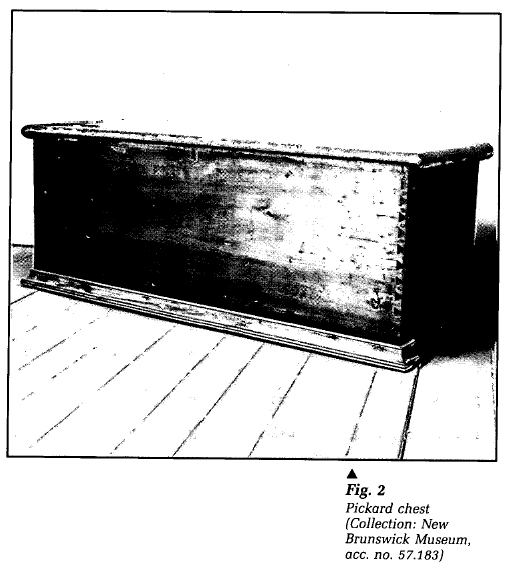 Display large image of Figure 3
Display large image of Figure 335 The fine William and Mary table shown in figure 4 was dated to 1720-40 when it was appraised by a prominent New England antique dealer some twenty years ago. This seems to be an accurate estimate, judging from the design and details of construction.
36 Popular in the late seventeenth century, turned-leg dropleaf tables were fashionable in America by the beginning of the eighteenth. The mirrored baluster turnings of the maple legs and stretchers on this example are correct for the period, and many similar examples survive from the Boston region.25 The squared birchwood top on this Pickard table is less usual than the oval-topped specimens so often illustrated in furniture reference books and sale catalogues. The leaves have a thumb-nail joint, and there is one drawer of white pine, 8 cm high and 21 cm wide, nailed, not dove-tailed, and with shaped wooden pull. The top does not seem to have been off its base, and the hinges appear to be the original ones.
37 The popularity of such tables, which appear in many New England inventories, was due to their versatility in the small, all-purpose rooms of the day. Closed and against the wall they took up little space; half open they served as a writing or work table; brought into the middle of the room and fully opened, they became dining tables. This one has a continuous history in the Pickard family, and after about 250 years of service is still in daily use.
Figures 5 and 6
38 The two Queen Anne tables described below have similar origins: eastern Massachusetts in the mid-eighteenth century. Both are fine examples of a type made at that time in the Boston-Salem-Newburyport region. Popular as space-savers, like the Pickard table (fig. 4), Queen Anne style dropleaf tables such as these were in vogue throughout the eighteenth century. Those that opened to a rectangular shape could be put together to accommodate larger groups. Stylistically, the Wells table suggests a later date than the Burpee one. This does not necessarily mean that the Wells table was indeed made later, although the history attached to each would suggest that this is so.
39 Considering the long period of popularity of its style, the Queen Anne table shown in figure 5 could have been made anywhere between 1730 and 1780. Its conformation suggests an origin in eastern Massachusetts. Family tradition says that the table came from New England, probably in the early 1760s, when Jonathan Burpee arrived from Essex County, Massachusetts, to settle in Maugerville. The table top, apron and legs are of tropical hardwood, probably Honduras mahogany; birch and pine are used for interior supports. Cabriole legs of a strong angular shape end in pad feet which rest on a wafer, a flattened ball formation characteristic of New England. The apron features a flattened arch whose pattern harks back to earlier William and Mary designs. When open, the D-shaped leaves complete an oval top. Never restored, this table retains its original hinges.26 The Maine Antique Digest of January 1988 reports that a similar table brought $5,225 in a recent New Hampshire auction.
40 William Wells, a Yorkshire immigrant, brought a Queen Anne table (fig. 6) to the Chignecto area in 1773. On the way to the region Wells stopped in Boston for several months and most probably acquired his table at that time.
41 This design is a coastal Massachusetts type dating to 1760-80. The double ogee curve of the apron and the high claw and ball feet with slightly raked side claws are typical of that era and region. The successful sweeping curve of the skirt is as important to the table's beauty as the configuration of its sturdy cabriole legs, which are bold enough to support the visual and actual weight of the deep rectangular drop leaves. A similar pair of tables, though with slimmer legs, was offered at Sotheby's in their New York Americana auction in January 1988 (item no. 1300). They are described as Massachusetts, circa 1770, estimated price $10,000 to $15,000.
42 The wood of the Wells table has been identified by antique dealers in Ontario and New England, consulted by the owner, as Santo Domingo mahogany, a heavy wood which became extinct in the early nineteenth century. The table descended in the family until offered at an auction in 1975 and bought by the present owner.
Figures 7-10
43 The following group of artifacts centres on the colony at the mouth of the St. John River, where activity revolved around Portland Point and its environs: the Simonds, Hazen and White trading post and the forts that guarded the river entrance.
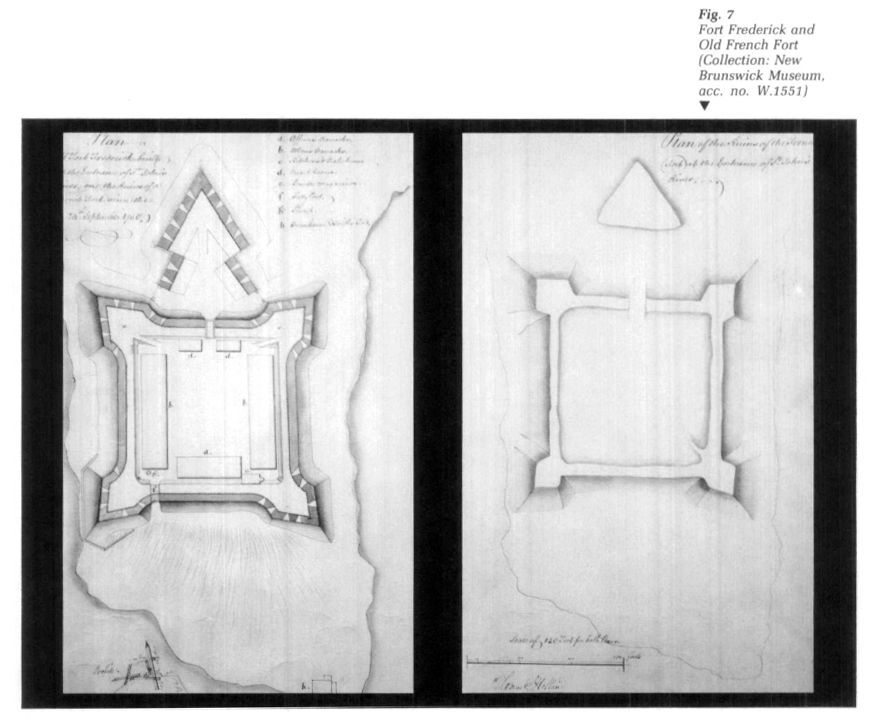 Display large image of Figure 10
Display large image of Figure 10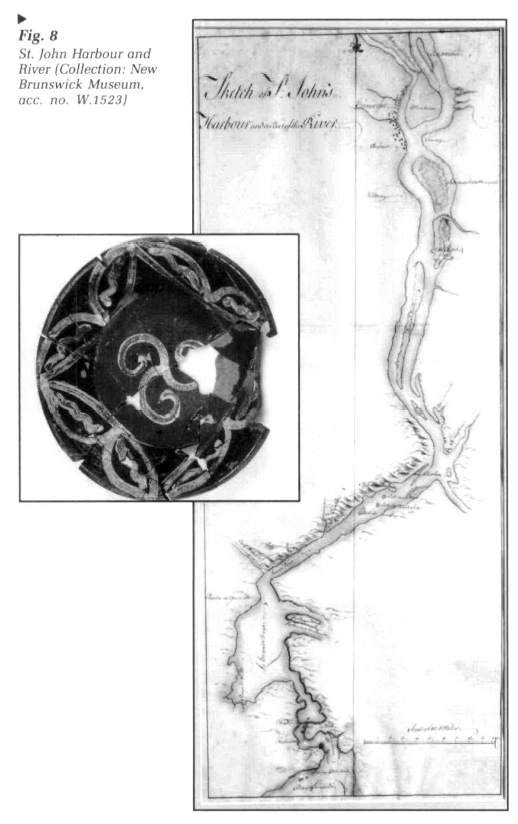 Display large image of Figure 11
Display large image of Figure 11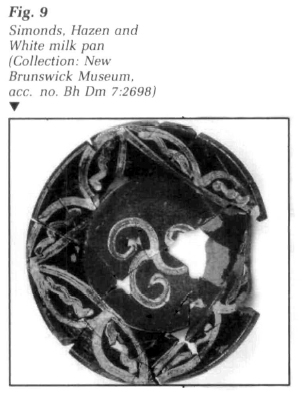 Display large image of Figure 12
Display large image of Figure 12 Display large image of Figure 13
Display large image of Figure 1344 Major Samuel Holland, a Dutchman who joined the British army, was sent to America in 1756 where he did extensive survey work.27 The two drawings of the old French fort and Fort Frederick (fig. 7) and the one of the lower reaches of the St. John River (fig. 8) were done on the spot in 1758. In September of that year Col. Robert Monckton was sent to the mouth of the St. John where he reconditioned an old French fort, rebuilding it into the new British Fort Frederick. It was for Colonel Monckton that Holland sketched this "Plan of the Ruins of the French Fort at the Entrance of St. John's River," and the "Plan of Fort Frederick Built at the Entrance of St. John's River on the Ruins of a French Fort, since the 24th September 1758."
45 Although the "Sketch of St. John's Harbour and a Part of the River" (fig. 8) is not signed by Samuel Holland, the letter formations and style of handwriting on both are identical. A note on the back of this one states that it was done for "Brigadier James Wolfe" whose forces had so recently taken Louisbourg.
46 The river map, done to a "Scale of 10 Miles," depicts the lower reaches of the river up to Grimross, present-day Gagetown. It reveals the large number of French place names, like île aux Noix, Villeray and Jemseg. Monckton's men penetrated as far upstream as Jemseg, in a "search and destroy" expedition against the Acadians.28
47 The milk pan or platter (fig. 9) is a typical example of the eighteenth-century redware pottery, unearthed during the 1955 excavation of Portland Point; two such milk pans were reconstructed from shards found in a garbage dump near the James Simonds house.
48 The firm's account books record the importation of ceramic milk pans in 1770 from their supply base at Newburyport, where several generations of the Daniel Bayley family operated a pottery between 1764 and 1799.29 Excavations at the Bayley dump in 1934 uncovered quantities of discarded redware material, including bowls, mugs, chamber pots, teapots, pitchers, dishes and large platters like that in figure 9, used for setting milk or raising dough.30 Redware, named for the natural colour of the clay, served all purposes in ordinary households. In richer homes redware was still used for food preparation, but for table and decoration lighter weight, more sophisticated dishware had become the norm. After 1830, when tinware became available, these heavy, breakable platters gradually vanished, as housewives gladly discarded them in favour of lightweight, shatterproof tin pans. A number of restored items from the Bayley dump are in the collections of the Smithsonian Institution, Washington, D.C.31
49 Unquestionably authentic, the elaborately decorated horn shown in figure 10 belonged to William Hazen, partner in the Simonds, Hazen and White trading post. It carries his name "William Hazzen" and the date "ano 1761" when he was serving with the Massachusetts Rangers in the Seven Years' War.
50 This is a handsome example of an engraved-map powder horn. It features a popular motif: the route from Albany to Montréal via the Hudson River and Lake Champlain, the favourite subject for French and Indian War map horns. Here the scenes include settlements and landmarks, ships, animals and the royal coat of arms with mottos. The skillful execution of the scrimshaw work suggests that this horn was engraved by a professional, possibly a fellow soldier. A similar 1756 horn, offered at the Christie's East auction on 8 November 1987, was bought by noted Connecticut dealer William H. Guthman for the record price of $53,800.32
51 The Hazen powder horn has been altered; a descendant had the horn fitted with sterling silver mountings for the tip stopper, ferrule and large end plug. The obligatory silver marks indicate a date of 1860-61 in London, England. The horn has a continuous history with the family and was a bequest to the museum.
Figures 11-16
52 Five related portraits in oil and one tempera miniature whose subjects are all pre-Loyalist men and women make up the next group to be discussed. All, with the possible exception of the miniature, were painted after the cut-off date of 1783, but each depicts a person who was in the region that became New Brunswick well before that date and who was important in the life of the times.
53 Until the advent of photography, a portrait was the best way to memorialize a sitter's place in society and his or her features for posterity. Few could afford the costly process. The subjects of the five oil portraits, however, belonged to the colonial elite; all were connected with the pioneer trading company of Simonds, Hazen and White. They are as follows: Elizabeth (Hazen) Chipman, Francis Peabody Jr., James White Jr., his wife Elizabeth and his sister Mary Elizabeth (White) DeVeber.
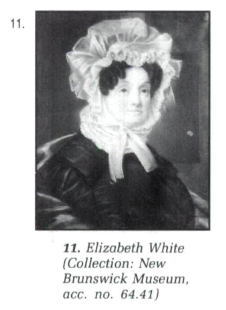 Display large image of Figure 14
Display large image of Figure 14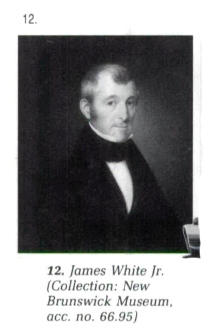 Display large image of Figure 15
Display large image of Figure 15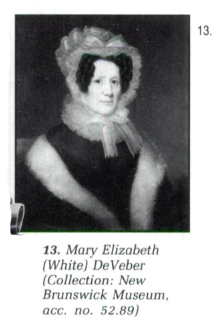 Display large image of Figure 16
Display large image of Figure 16 Display large image of Figure 17
Display large image of Figure 17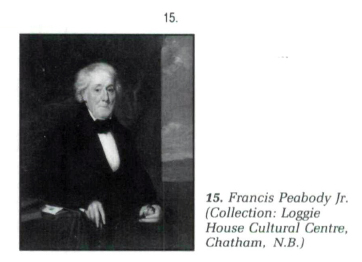 Display large image of Figure 18
Display large image of Figure 18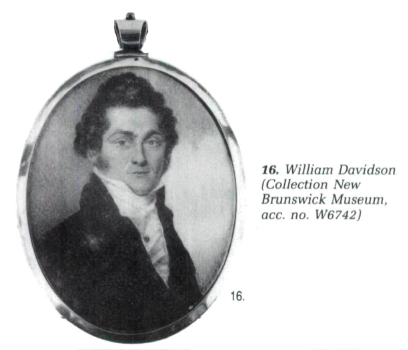 Display large image of Figure 19
Display large image of Figure 1954 The artists' names for only the first two paintings are on record. Recent research done in libraries, at the Museum of Fine Arts in Boston and in the Decorative Arts Photographic Collection of Winterthur Museum has resulted in a tentative attribution for the last three. The painter of the sole miniature of William Davidson remains unidentified.
55 The search for the painter of the portraits began with an examination of photographs of paintings by possible painters in the Maritime region, such as Robert Field and William Valentine, but these were ruled out because of painting period or style.33 Likely New England painters included Alfred Fisher, James Frothingham, Robert Street and Chester Harding. After studying several hundred images in art books and separate photographs of paintings, strong similarities became evident between a body of paintings done in Chester Harding's middle period and that of the New Brunswick portraits.
56 Chester Harding (1792-1866) was a farmer's son who began his painting career on the American frontier and by 1828 had become Boston's leading portraitist. Harding's principal aim was "always the likeness— above all else, a truthful representation of an individual face, presented 'warts and all.'"34 His technique changed over the course of his long career from the swift and daring brush-work of his early and middle periods, when his brush attacks and moves off fast, to a smoother, more uniform surface toward the end. His New Brunswick portraits do not have the size, the dramatic pose and the important scenic backgrounds used for his major paintings of important figures of his era; rather they belong to the class of plain, well-observed commercial productions, where he nevertheless continues to pay attention to the essential character of each sitter. Comparison of these portraits of pre-Loyalists with some of his recognized works reveal strong similarities in the treatment of his female sitters' lacy headgear (Mrs. Thomas Brewster Coolidge, Mrs. William Fulford Loman), while the pose and the handling of the James White Jr. portrait reflect that of his painting of Israel Munson, now owned by Harvard College.35
57 The sitter in figure 11 is Elizabeth White. She married James White Jr., son of one of the original partners of Simonds, Hazen and White. From her appearance and the style of her dress, this head and shoulders portrait was painted, in the 1820s to the early 1830s. It has its original rosewood frame, it is a competent portrait of a strong individual as evidenced by a firm mouth and reflective eyes. The painting was a bequest to the museum by a descendant.
58 As a small boy James White Jr., son of James and Elizabeth Peabody White, stood on the dock to watch the Loyalists land. He later became High Sheriff of St. John County. The portrait of White (fig. 12) suggests a man of contemplative mind and firm disposition. Here too considerable attention has been paid to accurate observation of features and expression. He is obviously a man accustomed to authority.
59 On the evidence of the clothes, the portrait was painted sometime between 1830 and 1835.36 Stylistically, this painting has many affinities with those of Mrs. White (fig. 11) and her sister Mrs. DeVeber (fig. 13). The painting was a gift to the museum by a descendant. The original frame is mahogany veneer.
60 The subject of the firmly handled head and shoulders portrait (fig. 13) was at the time the wife of Nathaniel DeVeber, High Sheriff of Queens County. The strong features of Mary Elizabeth White DeVeber are as carefully observed as those of her brother (fig. 12) and here too there are technical similarities, particularly in the handling of their "Peabody" noses which, stroke for stroke, could almost be interchanged in the two portraits. The date assigned to this painting is again the. 1820s to the early 1830s. The painting descended in the family until given to the museum.
61 Elizabeth Hazen, daughter of William Hazen, partner in Simonds, Hazen and White, married Loyalist Ward Chipman, a man prominent in the political life of Saint John. Somewhat late in their lives they went down to Boston to be painted by famous artist Gilbert Stuart. If it were not for the original invoice for this head and shoulders portrait of Elizabeth Hazen Chipman (fig. 14), it would be difficult to attribute it with certainty to Stuart. Most of his paintings have landscapes or drapery as backgrounds, rather than the dark, plain background seen here. The invoice details a cost of $100 each for the paintings of Judge and Mrs. Ward Chipman, $30 each for frames and $3 for packing, to a total of $263—a large sum for the date, 28 November 1817. The painting was a gift to the museum from a Hazen descendant.
62 Francis Peabody Jr., the founder of Chatham, New Brunswick, is depicted in the portrait shown as figure 15. Born in New England, Peabody (1760-1841) was the son of Captain Francis Peabody, the Simonds, Hazen and White associate who established a colony at Maugerville; like his father, the younger Peabody was a trader, shipbuilder and man of action. This portrait shows him as a elderly man, obviously of some importance. The painter was New England artist Albert Gallatin Hoit (1809-56), who specialized in portraits. He painted in Saint John in 1838 and in Halifax in 1840 and is believed to have gone to Chatham to do this portrait, commissioned by prominent men of the town.37 The white document with the large red seal in the portrait probably refers to Chatham's charter. The painting was placed on view in Chatham's Loggie House some decades ago.
63 William Davidson (c.1740-90) was a Scotsman from Inverness who in 1766 founded the first English-speaking settlement in northern New Brunswick, a fishing and lumbering enterprise on the Miramichi River. A decade later, unrest and destruction resulting from the American Revolution forced him to retire to Maugerville on the St. John. He returned north again when peace was established.
64 The tempera miniature on ivory (fig. 16) depicts Davidson as a man in the prime of life, and the style of dress suggests that it was painted in the last decade of his life, between 1780 and 1790. The miniature was a gift to the museum from the Davidson family.
Figures 17-22
65 Objects in the next group come from the Sackville and Fort Beauséjour areas of New Brunswick. In the immediate pre-Loyalist period Fort Beauséjour was named Fort Cumberland, but reverted to its earlier French name in this century, as Fort Beauséjour National Historic Park.
 Display large image of Figure 20
Display large image of Figure 20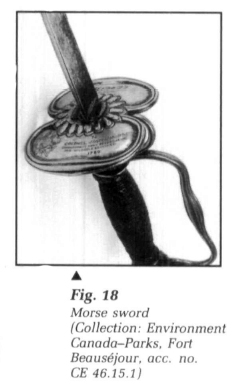 Display large image of Figure 21
Display large image of Figure 21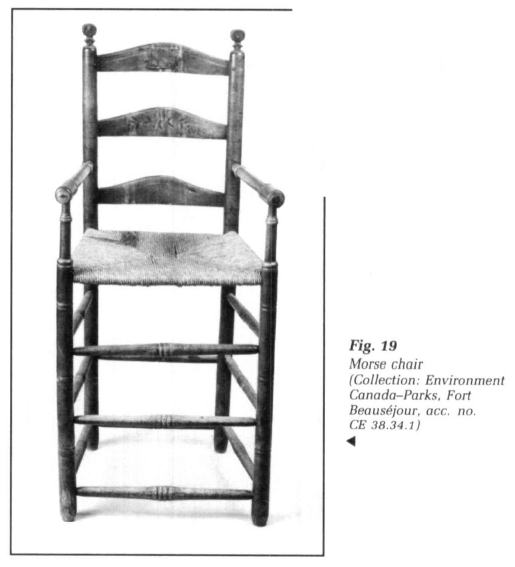 Display large image of Figure 22
Display large image of Figure 22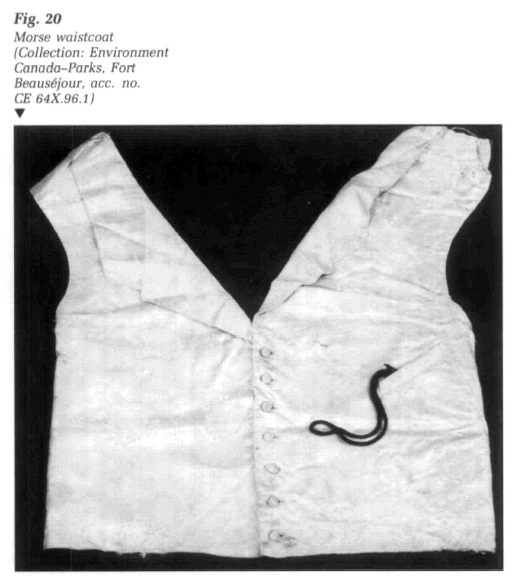 Display large image of Figure 23
Display large image of Figure 23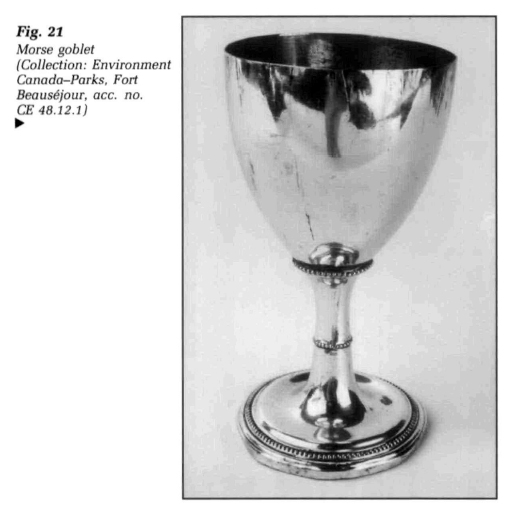 Display large image of Figure 24
Display large image of Figure 24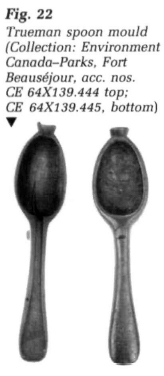 Display large image of Figure 25
Display large image of Figure 2566 The drum seen in figure 17 descended in the Goodwin family from the time of drummer boy Enoch Goodwin. His name appears on a regimental list of 1784, when the unit was disbanded, as does that of his father, Daniel Goodwin, listed as a sergeant on the same roster. The senior Goodwin emigrated from Newburyport, Massachusetts, in 1755. The drum is now over-painted with the cipher of George Ⅲ and the name of the 2nd Battalion, Westmoreland County Militia. Infra-red photography, and possibly paint analysis, may reveal an underlying inscription of the original regiment, the Royal Fencible Americans, which was formed during the American Revolution. The pattern of such drums changed little over several hundred years; consequently, little can be learned from its configuration. The rims are fitted with the correct arrangement of lacing holes, but the cords are an obvious replacement for heavy service ones, and the leather ears are longer than the usual pattern. The drumhead has a large hole in it. A gray (once white?) leather handmade belt goes with the Goodwin drum; it is fastened with a metal snake clasp and has an inscription burned into the reverse side: "89th Reg. F93."
67 Very little has been published on antique drums, particularly military ones; it is a neglected area, falling between categories, since drums are neither weapons nor accountrements.38 This specimen is on loan from the Goodwin family.
68 The infantry officer's sword (fig. 18) belonged to Col. Joseph Morse in the mid-eighteenth century. The Morse sword is state-of-the-art, and its configuration conforms with officers' swords in use during the Seven Years' War.39
69 George II is said to have presented the sword to Morse for his services in the war, and there is a problem with the inscription on the counterguard; "To Colonel Joseph Morse, commandant Fort Beauséjour for valuable services 1760"; an engraving of the royal coat of arms appears in one corner.
70 In all probability this inscription is not contemporary, but was placed on the sword considerably later by a descendant. The lettering, for instance, is in block capitals and sans serif, quite out of keeping with an eighteenth-century origin. The "G R" of the coat of arms is also block capital, casting doubt on this feature as well. Further, by 1760 the fort was known, not by the French name of Beauséjour used on the inscription, but as Fort Cumberland. There is no trace in the fort's records of Colonel Morse as commandant, although he was stationed there and took up land in the vicinity in 1764. He was buried in tho graveyard at nearby Fort Lawrence.
71 Whatever the status of all or part of the inscription, the sword itself is genuine and a fine specimen of the type.
72 A plaque placed on the back of the yellow birch ladderback or slatback chair of the group (fig. 19) reads: "This chair once the property of Col. Joseph Morse 1721-1770. Used by him at Fort Cumberland, Is presented by his descendant Sr. Frederick Williams-Taylor 1938." Sir Frederick may well have also been responsible for the inscription on the sword (Fig. 18).
73 Information on the curatorial card at Fort Beauséjour states that the chair was "specially made to fit Governor of Fort Cumberland area, a huge man who was seven feet tall." There is, however, no trace of this unusual height in the records, and the story is possibly an attempt to explain the unusual height of the chair's seat from the ground. Most probably this is an accounting chair, made to fit under a high bookkeeping desk.40 Morse served as commissary officer in a previous post at Fort Oswoga and in this capacity dealt with accounts; he may have done the same at Fort Cumberland.
74 Such ladderback armchairs were by far the most common form of seating in America throughout the seventeenth, eighteenth and nineteenth centuries because they were an inexpensive and serviceable style, costing a fraction of chairs produced by cabinetmakers. Early designs are often perpetuated in later models.41 The Morse chair is an unusual piece, presenting several problems. The green-paint design on the back slats is certainly a later addition, and the curves of the finials or ears have been rasped to present a flattened profile, as a style feature or to adjust an injury. The form of the turned and shaped handrests is also uncommon, but the shallow turnings on the chair legs and three sets of stretchers, handmade, freehand on a lathe or with a knife, are perhaps the most unaccountable features; earlier prototypes show fuller, more robust turnings. It is these understated, more delicate design elements that have inspired the suggestion that there may be an Acadian influence here; numbers of Acadians were still in the Cumberland area and were employed in many capacities by settlers in the vicinity of the fort.42
75 The Morse waistcoat (fig. 20) is the only piece of pre-Loyalist English textile so far found. It is a section of the waistcoat once worn by Colonel Morse, and its narrow proportions suggest another reason to doubt the tradition that he was seven feet tall. The garment has obviously been cut down and is much too short for a waistcoat of the middle to late eighteenth century; cut edges are visible at the bottom. However, the pale yellow silk damask fabric is woven in a design that conforms to contemporary tastes. In the late seventeenth and early eighteenth centuries fabric patterns were bold, in keeping with furniture designs. By the mid-eighteenth century textile patterns were being made in moderately small flower and leaf patterns, which suited the lighter style of clothing and furnishings. The size of the waistcoat's self-covered buttons is also appropriate to the period.
76 The goblet (fig. 21) is from a set of twelve said to have belonged to Colonel Morse and has been dated to 1750-1800. The classic shape and the decoration could well assign it to the final quarter of the eighteenth century, particularly if it is English. The fact that the goblet is silver-plated brass does predicate an English origin. No maker's mark is discernible on the base, however, and a set of goblets of similar shape but more elaborate design was made by Paul Revere for Nathaniel Tracy of Newburyport in 1782.
77 The bronze mould (fig. 22) was used to fabricate pewter spoons in the William Trueman household. Its shape and proportions are mid-eighteenth century, with the typical rat-tail showing on the bottom of the bowl. Spoon moulds of this type were in use until the last decade of the century in England and America.43 The Truemans had emigrated from Yorkshire in 1774, and at this time pewter was in widespread use for many household and personal objects, from buckles through plates, teapots and spoons. Cheaply plated silver gradually replaced this soft and easily bent alloy.
Figures 23-26
78 The tallcase clocks in these figures have similar origins. The works were brought from England by Yorkshire settlers and in most instances bear the makers' names on the brass dials. The clock cases, however, were made after their arrival in the Chignecto area by local craftsmen or possibly by family members. The parallel construction features suggest that a single craftsman may have made most of them.
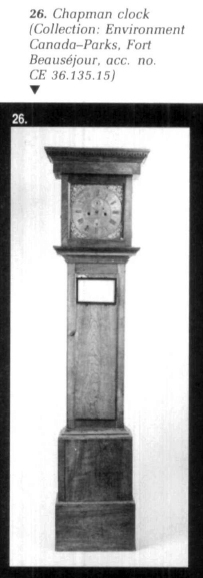 Display large image of Figure 29
Display large image of Figure 2979 The Trueman clock (fig. 23) is unusual in that it is made with a single hand. Such clocks, simpler and cheaper than two-handed ones, were more frequently made for country use, since in rural life the precise moment of time indicated by a second hand was seldom needed.44
80 The maker's name is inscribed in italic lettering around the bottom of the dial between V and VII: "R. Henderson, Scarborough"; he is a listed Yorkshire clockmaker, whose dates are 1678-1756. Several of his clocks have been collected and described.45
81 Although the design is a classic, a simpler copy of a plastered type made famous by noted clockmaker Thomas Tompion of London (c. 1695), the visible plates of the butt hinges on the door suggest a certain lack of skill in the maker who was likely a local craftsman. The case and hood are white pine, the case door is tamarack. The clock remains in family hands. A similar one-handed clock is in the York Castle museum.
82 Like most of the other clocks in this group, the works of the Dixon clock (fig. 24) came to the Chignecto region with Yorkshire settlers—in this case, with Charles Dixon in 1722. Again, the case was locally made, entirely of white pine, and the curve of the cove moulding on its hood is very similar to that on the Trueman clock. Both hood and body show signs of later repairs.
83 At the bottom of the dial between V and VII the maker's name appears in script letters: "John Bentley," and just below it, between 25 and 35, "STOCKTON," for Stockton-on-Tees. Bentley too is a clockmaker of record.46
84 The design of this brown-painted case is like that of the Trueman one, but without pilasters on either side of the glazed hood door. The bodies are alike in shape and proportions, with plain doors, but the Dixon clock's workmanship is more skillful and the hinges on its door are properly placed with only the pintle visible. The curve of the cove moulding on hoods and bases are also similar, although the Dixon case is plainer. This clock is owned by a Dixon descendant.
85 Christopher Harper came from Yorkshire in 1774 to settle and keep a store near Fort Cumberland. The brass face of his clock (fig. 25) is inscribed "Kidd, Malton." Kidd and Sons of Malton, Yorkshire, were active as clockmakers from the mid-1760s well into the first quarter of the nineteenth century.47
86 This pine clock has the plainest case of the group, with both leaves of the late-eighteenth-century hinges visible; the edges of the dial and decorated spandrels are partially obscured. Two tall clocks with similar obscured edges are illustrated in Howard Pain's Heritage of Upper Canadian Furniture, where they are cited as survivals of eighteenth-century British cottage style.48 The clock remained in the Harper family until purchased in 1979 by the present owner.
87 The origin of the Chapman clock (fig. 26) is different from that of the others in this group; the brass face and works came from America, not Yorkshire. How and when William Chapman (a Yorkshire immigrant of 1774) acquired these works is not known, but a likely explanation would bo that he got them from a returning New Englander.
88 On the clock face, between V and VII, is the maker's name; "Jos. Phillips, New York." He too is a clockmaker of record, noted as working from 1713 to 1735.'49 The yellow birch body and base are similar to those on the other Yorkshire settlers' tallcase clocks, though with a shorter waist. This clock, with its sawn and chiselled hood decoration, is the best crafted of the four. Peter Etter, a skilled craftsman at Fort Beauséjour, who dealt with clocks and watches, may well have had a hand in the clock's construction. A plaque on the front reads, "Clock made for William Chapman who came from Yorkshire in 1774, and settled near the Missaguash River. It is probably the oldest example of its kind in existence made in Chignecto."
Figures 27-30
89 The lives of the Yorkshire settlers are further examined with this last group of artifacts.
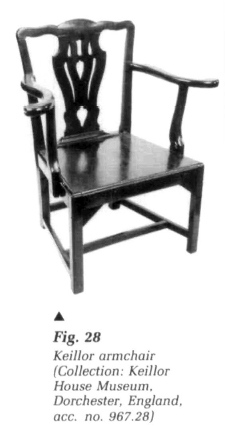 Display large image of Figure 31
Display large image of Figure 3190 Family tradition has it that the roundabout, or corner, armchair (fig. 27) was brought from Yorkshire by William and Ann Trueman when they came out on the Albion in 1774. It once had a high comb and crest rail, already missing when the family emigrated. The marks of such a comb are still visible on the present crest rail.
91 The chair's strong, stocky shape does indeed suggest an English origin, sometime between 1740 and 1770; it does not resemble American examples. Here microscopic wood analysis had aided in establishing a country of origin. The use of yew, for instance, would predicate an English origin, but this chair is yellow birch throughout (Betula allegheniensis Britton), a species native to North America. It is a vernacular piece, a simplified, heavy version of transitional Chippendale, and the lap joint, visible above the centre back post, is one commonly used in the eighteenth century for strength and to economize on wood. Wood pegs hold it together, and the Queen Anne slats, scrolled arms and Marlborough legs are hand carved, not machine turned. All of this suggests that the chair may have been handmade at the family's new home, borne out by the fact that farmer William Trueman was also a qualified joiner.50 The chair is still in family hands, in daily use.
92 In 1772 the Thomas Keillor family emigrated from Skelton, Yorkshire, in the first wave of North Country settlers, reportedly bringing the chair shown in figure 28 with them.51 This handsome armchair is a good example of country Chippendale, in this case, a simplified sawcut version of the carved designs in Thomas Chippendale's mid-century design book, executed in robust proportions which strongly suggest an English origin.52 But here again microscopic wood analysis reveals that the wood is birch, stained to resemble mahogany, a common eighteenth-century usage for this wood. The chair is not elegant shop furniture but was probably done by a good country workshop or skillful craftsman. It is much restored, a mixture of old and new, with a replacement seat of Douglas fir.
93 The painting (fig. 29) is of Prospect Farm, the house the Truemans built some years after their arrival in Canada. It stood facing south on Beauséjour Ridge, with a magnificent view over a wide expanse of country, and its bricks were made of clay from nearby Tantramar Marsh.
94 Although built after 1783, the house is shown because it is an example of the type of dwelling prosperous Yorkshire famers built once they became established. It had a wide hall, according to records kept by the family, with four rooms downstairs and the same above, as well as a spacious attic and a one-storey kitchen at the back; seven fireplaces provided heat. Early in the nineteenth century the stone kitchen was removed and a large annex built in its place.
95 Dr. Elizabeth McLeod, head of Mount Allison University's art department, painted this "portrait" of Prospect Farm as it stood in 1917; that same year the house was demolished because of constant problems with shifting and cracking. The keystone from above the front door, with the carved date of 1799, was saved and incorporated into a second-storey fireplace in the replacement house. The painting is still in family hands.
96 The Chapman (fig. 30) house is a substantial structure standing on the ancestral farm that straddles the border between New Brunswick and Nova Scotia. It was constructed in 1779, and for more than two centuries has been occupied by the descendants of William and Mary Chapman.
97 Similarities of style between this and the old Trueman house are immediately apparent. Both are outstanding examples of the spacious late-eighteenth-century houses that lesser gentry and prosperous yeomen of the time felt compelled to erect. The house has a central hall, with rooms opening to left and right; winding stairs lead to the second storey where, although there is a central hall, the rooms all lead in and out of each other in the style of earlier Tudor and medieval dewellings. There is a large open attic.
98 As in the Trueman house, fireplaces were the source of heat here, with flues leading into two huge chimneys at either end of the structure. Although in Britain there was a tax on windows, in Canada no such tax existed; thus the Chapmans lighted their large, low-ceilinged rooms with good-sized, wide-silled windows. This was a feature of Canadian houses admired by visitors from the old country, who remarked on the "light and pleasant" effects.53 Many of the original fittings remain: door latches, a chimney piece and the massive brass hinges and lock of the front door. The handmade bricks were formed from the clay of the surrounding marshes and burned in kilns close by. Although the execution of the brickwork is rough, the design is outstanding and exhibits "the basic form and many details of a prosperous eighteenth century farmhouse."54
Conclusions
99 What do these artifacts say about the original owners and their world? Chance survivals cannot be expected to provide a complete and balanced picture; some conclusions, however, can be suggested, and placed in a larger historical perspective.
100 When the flood of Loyalists arrived in the early 1780s—thereby transforming the political, economic and social life of the region—the pre-Loyalist settlers had already established viable settlements in an English-speaking province. The very different situation that had prevailed before their coming is vividly illustrated in the two Holland maps of 1758 (figs. 7 and 8); these mark the change from French dominance to English hegemony, in Canada as a whole and Nova Scotia in particular. In these maps Col. Robert Monckton erects his fort on the ruins of the French one; along the St. John River the French place-names on the map are soon replaced by those of British royalty and officials—no longer Villeray and Choufours, but Fredericton, Gagetown, Maugerville.
101 The Goodwin drum (fig. 17) bears witness to the armed conflicts that troubled the region throughout the eighteenth century. Colonel Morse's sword (fig. 18), with its sophisticated scooped blade that delivered a festering wound, displays the constant of human ingenuity ever focussed on state-of-the-art killing.
102 Two other items carry a more cheerful message of self-sufficiency. William Hazen's powder horn (fig. 10) indicates the self reliance of colonial troops who brought their own basic equipment; the Trueman spoon mould (fig. 22) speaks to domestic self-sufficiency. Also in the domestic sphere, the Simonds, Hazen and White milk pan (fig. 9) tells of the cumbersome equipment eighteenth-century housewives had to deal with.
103 The portrait paintings of pre-Loyalist settlers (figs. 11-15) illustrate how rapidly the circumstances of life in this region changed in a few decades: from extreme physical danger and hardship in youth to a comfortable and affluent life in middle age. The furniture also has something to say. The three tables (figs. 4, 5 and 6) were indeed space savers, useful in the small-roomed houses of early New Englanders, but they and the desk (fig. 1) are also of good quality. These settlers, though they came for free land, knew and valued quality and believed themselves entitled to it. Care was taken to see that these items survived, and with the furniture, it might be argued, certain standards were also passed on to descendants. In a different context, Colonel Morse's ladderback chair (fig. 19), with its suggested Acadian influence, alludes to the well-attested presence of hundreds of Acadians in Nova Scotia, who had evaded transportation or returned, and who were working with the new English-speaking settlers.55
104 The Yorkshire artifacts also cast light on several subjects. The Wells table (fig. 6), bought in New England on the way to Nova Scotia, indicates that the family not only had an eye for good style, but also enough disposable cash to buy land and quality furniture—"men of substance" indeed. The tallcase clocks (figs. 23—26) reflect Yorkshire good sense: high quality works installed in simple local cases; function, not show, was what mattered. The handsome houses these Yorkshire people built bear witness to their past and continuing status as people of some standing and importance in the community and to their adaptability. They altered old country forms to suit new conditions, lighting their Nova Scotia homes with more windows (and taking canny advantage of no taxation on light), and warming them with more fireplaces against the bitter winters. Thus they adapted their houses, as they had successfully adapted their knowledge of dyking and farming to new conditions. Nevertheless their way of life reflects a life-style in transition. In the Chapman house, ground-floor rooms lead off a central hall, but on the second they continue an older pattern with each room giving access to its neighbour: modern attitudes to privacy had not yet taken over.
105 During this study of the form, function and history of these surviving artifacts other specific insights have emerged to suggest their meaning and place in the lives of the Pre-Loyalists. These objects are here today because they come from families who cherished their links with the past and who believed in the importance of maintaining continuity with the people who overcame hardship and peril to establish today's communities. Joseph Howe declared that remembering past glories and sacrifices fostered a love of country. He would have been pleased to see this pre-Loyalist heritage so lovingly preserved.
I would like to thank the following for their assistance: S.C. Ridlington, Catherine Stright, Fort Beausêjour; Sylvia Yeoman, Doreen McAllister, Keillor House; Cynthia Wallace-Casey, York-Sunbury Museum; Gregg Finley, Darrel Butler, King's Landing; Stuart Smith, Marc Schneider, University of New Brunswick; David Miles; David Staples; Tim Isaac; Marie Elwood, Nova Scotia Museum; James D. Snowdon, Acadia University; Donald B. Webster, Mary Allodi, Royal Ontario Museum; Charles F. Hummel, E. McSherry Fowble, Donald L. Fennimore, Philip Zimmerman, Nancy Goyne Evans, Bert Denker, Beth Twiss-Garrity, Marjorie Andreen, Winterthur Museum; Jonathan L. Fairbanks, Jeanine Falino, Carol Troyen, Museum of Fine Arts (Boston); Brock Jobe; Jay Cantor, Christie's (New York); the Truman, Dixon, Chapman (Carter), Pickard families; and the staff of the New Brunswick Museum.
